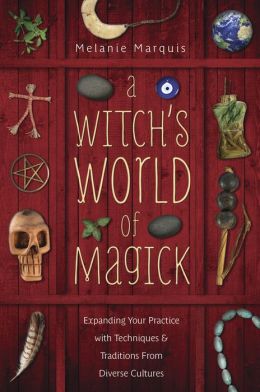I’m always up for any book that offers me practical activities that help me deepen my spiritual practice. A Witch’s World of Magick does that, breaking down magical practice into types of hands-on workings such as potions, spells of containment or binding, mimicry magic and more. Each chapter offers examples of a particular type of magic from cultures around the world, then guides the reader in ways to add those practices to their own magical bag of tricks. The overall thrust of the book is a search for the common threads that bind magical practice worldwide and that the modern practitioner can ethically use for a positive effect in their life.
Ms. Marquis begins her book with a chapter about magic without tools. In her words, “Basically, if you can’t make magick without tools, you can’t make magick with tools, either.” I was very happy to discover this section since most books out there don’t even address this subject (though thankfully, many individual spiritual teachers do). No-tools magic, as she calls it, is true magic. You are the only tool. If you take away nothing else from this book, understanding this one chapter will help you become a more powerful, more responsible practitioner.
Each chapter begins with examples of the chapter’s particular type of magic from various worldwide cultures and traditions. I like that Ms. Marquis includes examples from Polynesia, Africa and Asia as well as Europe, since these regions are often under-represented on magical bookshelves. However, most of her examples felt stale and not terribly relevant to the modern reader. Most are from 19th-century texts that are not necessarily considered reliable any more (Frazer’s Golden Bough and Leland’s Gypsy Sorcery and Fortune Telling, for instance). I might not have felt so disconnected from the magical traditions Ms. Marquis cites if the references had been listed at the end of the book, but the footnotes were located at the bottom of each page, encouraging me to glance down as I read and check out each reference. By about the tenth time I saw a reference book publication date from more than a century ago, I began to wonder why the author was using these sources. There are plenty of more recent references available in folklore and anthropology books, though they might require a trip to the library. Ms. Marquis’ footnotes show that she found most of her sources at the online Internet Sacred Text Archive (sacred-texts.com).
Toward the end of the book Ms. Marquis includes some modern examples, such as the famous Yankees/Red Sox curse from 2008, which felt more relevant. In fact, she includes several instances of magical workings (mostly curses and cursebreaking) from modern sports. I find it interesting that beliefs that are poo-pooed as ‘superstition’ in mainstream culture are still taken seriously in the sports world.
In each chapter, after the examples of each type of magic, Ms. Marquis offers activities for the reader to try using the chapter’s focal variety of magic. These activities are not duplicates of the historical examples she offers in each chapter, but are simple, modern magical workings that anyone can perform with a little concentration and dedication, but that also act as doorways into a deeper exploration of each kind of magic. In other words, the ‘practical application’ part of the book will work well for readers of just about any level of magical expertise.
The best part of the book is the Points to Ponder section at the end of each chapter. It is a list of open-ended questions about the type of magic each chapter focuses on, and encourages the reader to explore the subject more deeply and find the meaning it has for them. These are the types of questions a good teacher asks, leading the student in a direction that allows them to learn and discover for themselves.
I found the chapter on cursebreaking particularly interesting. Instead of just launching into a list of cursebreaking activities, Ms. Marquis leads the reader through a checklist to figure out whether they’re actually cursed. Too often we jump to conclusions when we have a run of bad luck, and many of us sabotage ourselves, either consciously or unconsciously. The author addresses these kinds of situations and helps the reader determine the best and most responsible course of action. I was gratified to read her suggestions for lifting a curse you’ve inadvertently put on yourself (self-sabotage) as well as methods for reversing magic you wish you hadn’t done. These are very helpful skills that every practitioner should have in their magical toolkit.
In spite of what I felt were somewhat stale historical examples, I did find this book to be a worthwhile read. Since none of the activities center on deities or pathwork, it is usable and practical for anyone who wants to work with magic and energy, regardless of their personal belief system.
~review by Laura Perry
Author: Melanie Marquis
Llewellyn Worldwide, 2014
pp. 224, $16.99

